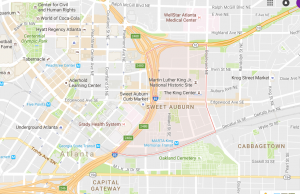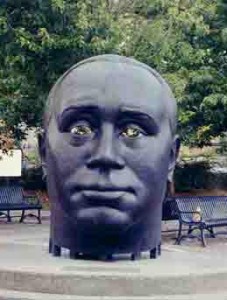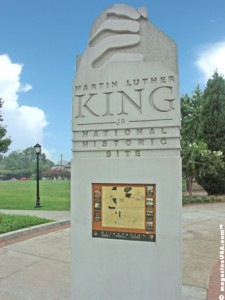Part 1: Segregation of Auburn Avenue
People tend to believe that the environment shapes the individual, in this scenario, the built environment would then act as the mold in which the area finds itself. This is not true, rather, it is within the decisions an individual makes that shapes his or her outcome, translated to context, the decisions of Auburn Avenue, or “Sweet Auburn,” are reflected by its built environment. Originally a white-owned commercial district called “Wheat Street,” renamed in 1893 to Auburn Avenue, Sweet Auburn (coined by John Dobbs) is located just miles away from bustling downtown Atlanta, Georgia. The built environment of Auburn Avenue looks the way it does today due to its decisions regarding its long history of segregation and its cultural representation of Civil Rights.
As Jim Crow laws ran rampant throughout the South, particularly in Georgia, African Americans were left to little choice in decisions on where to live. Jim Crow confounded the black American population in the parameters of Auburn Avenue. The beginnings of Sweet Auburn were bleak, yet the effects of its environment did not hinder its rise to success. Rather than wallowing in their powerlessness, the African American community banded together, and through their decisions, created the legacy that still rings to this day, despites it’s exponential declination, as the once, most thriving black business district in the world.
The original built environment of Auburn Avenue was loaded with business left and right. Here are but some of the most iconic buildings, whose remnants remain to the present day; Atlanta Daily World, Atlanta Life Insurance, the Royal Peacock, and the famous Ebenezer Baptist Church. These buildings are of the few prominent structures that made up Sweet Auburn built environment, and although most of them are either torn down or long abandoned today, they still stand among others as components of the built environment.
Segregation, a political movement in its right, has shaped the street and its immediate area into what it is today. Despite the negative connotation that segregation entails, there can be no denying its role in the creation of Auburn Avenue, as its being contributed greatly to the overall development of The build environment. The projection of segregation in its built environment can still be seen today as the age-old buildings, including those mentioned above, stand testament to the atrocities and unfair treatments the street and its citizens faced, as their existence came to be due to the implications of Jim Crow.
Part 2: Civil Rights Movement
When Auburn Avenue is brought up in conversation, the Civil Rights Movement is never far behind, it may not be explicitly mentioned, but its presence is still ever-present. The street gets such an association by right, as influential leaders who came to be the spearhead of the movement were, for the most part, borne on the Avenue. Leaders such as John Dobbs and Martin Luther King are but two prime examples. The civil rights movement leaves its mark through not only equal right bills pass, but also through the built environment of Auburn Avenue.
Two blatant structures that lend a hand to the notion of civil rights impact on the built environment of Sweet Auburn are in memory of two great leaders of the movement. The first being the statue of John Dobbs, located at the John Wesley Dobbs Plaza. John Dobbs was a strong advocate and fighter for the civil liberties as he dedicated his whole life to the advancement of African American standing upon white American society. Dobbs preached the importance of suffrage as the “key to racial advancement” (John Wesley Dobbs) and encouraged thousands of black Americans to register. Due to his insistence on the importance of voting, the African American helped won Hartsfield his seat as Mayor of Atlanta, resulting in two major victories for the community. Through extensive work on Dobbs part, he got Mayor Hartsfield to fulfill the desegregation of the police force (despite being very limited in scope), as well as the installation of street lamps on the Avenue. Through politics, the built environment of Sweet Auburn took on change as new infrastructure was introduced. The statue of John Dobbs head then further illustrates the streets commitment and sentiments towards those days of civil rights and demonstrates the role the movement had on the present physicality of the street.
Martin Luther King Jr also places his names on the annals of Sweet Auburn history, as his Historic Center, the King Center has brought national acclaim worldwide, boasting visitors from all over the world. Martin Luther King Jr. has become a common household name, one that has been associated deeply with the civil rights movement. Dr. King, like his predecessor, John Dobbs, fought for civil liberties of all humankind through non-violent means, his involvement help brought the issue onto a national level, and his achievements in the field of civil liberties have rocked the modern world. His historic center stands representation of everything King, which in turn means it stood for everything civil rights. Taking into account the prominent position the center holds on the street, its constant care and promotion, there is little left to the imagination on the magnitude of its importance on the built environment.
Established by Mrs. Coretta Scott King in 1968, the King Historic Center still stands to this day as a beacon for the ongoing fight for civil liberties. Put up to change. The center will undergo modifications in its presentation so as to become a more “energetically-engaged educational and social change institution.” (About The King Center) The aspiration to fit into modern societal context further emphasizes the importance of the civil rights movement on Auburn Avenues image.
The center, alongside the statue of John Dobbs, gives credence to the notion that the streets built environment came about due to its heavily enforced history and political affiliations of days past. The statue stands watch over the street, as the King Center preserves the historic movement through its leader, bearing testament the progress made by African-Americans, and all Americans alike, in the fields of liberty and justice.
Part 3: Declination of the street due to its insistence on historical preservation
Everything about Auburn Avenue screams historical importance, so much so that an argument can be made that it is the very preservation of said history that has caused the exponential declination of the street. Sweet Auburn, in no way, represent its former glory, and rather than aging gracefully, Auburn Avenue seems to be stuck in between the times.
A street with so much history embedded with the feelings of hundreds of thousands, it comes to no surprise the extent to which Sweet Auburn goes through to further prolong its historical heritage. The old buildings that appear all along the street, those still in use, as well as those abandoned, all serve in creating the Avenue’s historic façade. The appearance of these buildings brings along a very out of time and out of place kind of feel. When you are walking along the street, especially so towards the undeveloped latter half, it seems as if you have taken a step back in time. In no ways, a bad thing was it in moderation, but so obsessed is the street in the preservation of such feelings, that it has, instead of a trampoline to further propel and set the street apart from others, created for itself an anchor in the sea of time. So heavy is that anchor, however, that the Avenue has begun to sink.
Officials, like Councilman Kwanza Hall, have just recently started looking towards revitalizing the street through a series of new renovation. As Councilman Hall stated in his interview with CNN, he knows that there is a “very rich treasure in terms of African-American history” (Sweet Auburn Avenue: Buildings Tell Their Story). He wishes to preserve some of the streets façades. Councilman Hall himself spoke of the implications of moving multiple boards onto the project of Sweet Auburn’s revitalization, as conflicts arise with differing goals. New renovations and buildings may be denied due to implicating some historic building or an area under review may have, attached to it, historical importance and therefore any and all ideas about that particular area are scrapped. Both residents and businesses alike, look towards the every increasingly empty street and although they sympathize with historical preservation, they also believe that it should in no way impede on progress.
Auburn Avenue’s persistence on the preservation of its historical heritage further illustrates the importance of history on the fabric of Sweet Auburn’s life. With so much protection and the abundance of historical buildings, the built environment of Auburn Avenue reflects its history and looks the way it does today due to its decision concerning the preservation of historical buildings.
Conclusion:
The built environment of Auburn Avenue has remained more or less the same throughout its long history. There are indeed new introductions as Georgia State University, situated near the Avenue, begin to expand its downtown footprint. The decisions of Sweet Auburn itself, however, still stand responsible as to how it wishes itself to be viewed, by both within and outside its bounds. Auburn Avenue became what it was through politics. It is what it is today through the same politics. The Street is constantly changing, reshaping itself and redefining its presence, all due to the influence of politics. The decisions Sweet Auburn made in regards to politics is seen through the built environment, as I have mentioned previously in the political reflection of the street. Same as politics, the different choices have all lead to the look of Auburn Avenue today, from its preservation of history to their continuation of certain heritages, such as the civil rights movement with its Historic King Center.




